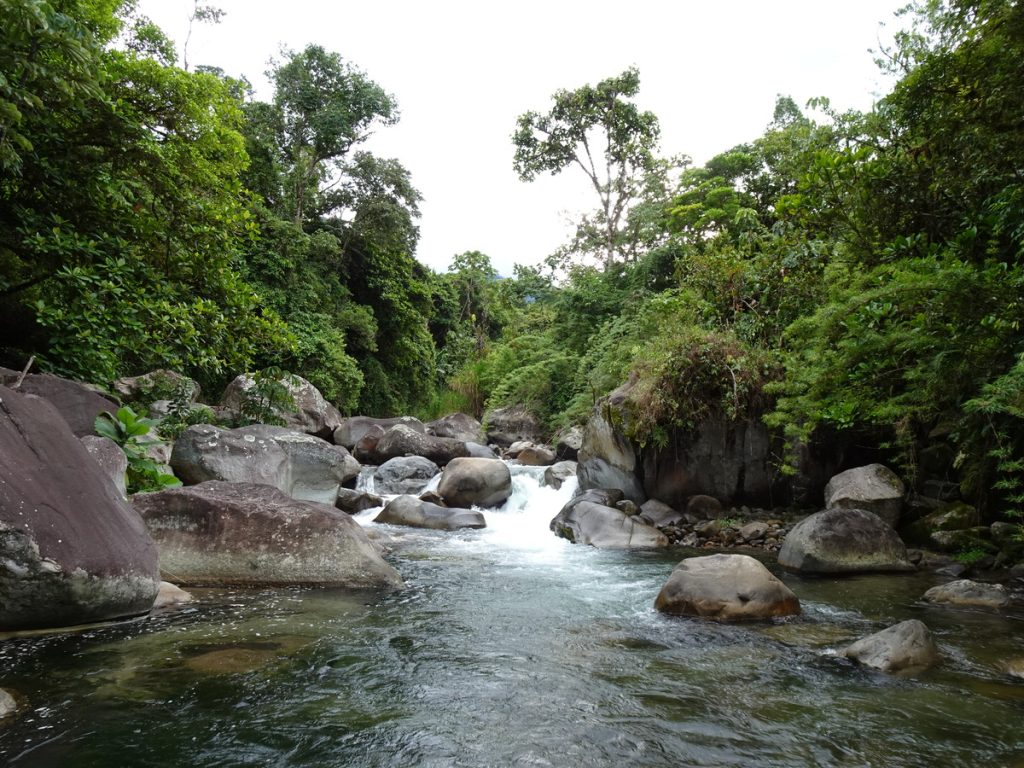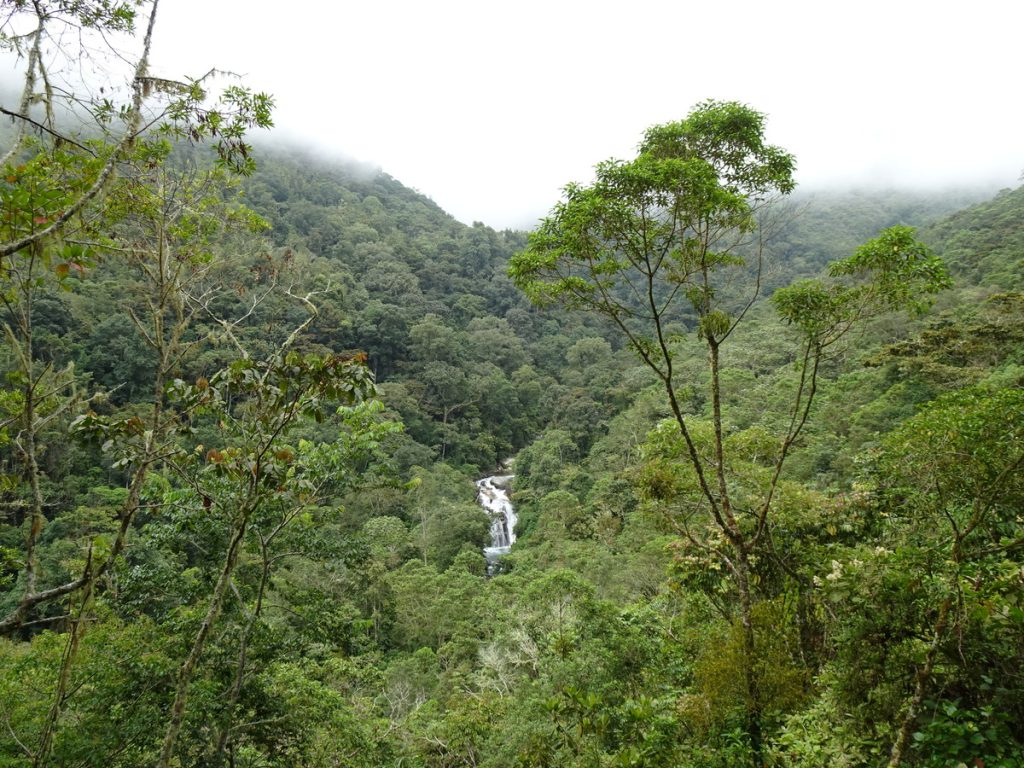Getting from A to B in Costa Rica takes time, and it’s worth factoring this in when planning your itinerary. Our first stop was San Gerardo de Rivas, a 150km-ish journey from the capital San José. Not that far, I hear you say. Throw in the Talamanca Mountains, steep, pothole-strewn roads, a cycling event and a bus connection in San Isidro de El General and you have a journey that takes the best part of eight hours. Fortunately, it’s worth the effort. San Gerardo de Rivas was the most peaceful spot we visited, and the perfect introduction to Costa Rica’s wildlife and varied landscapes.
We arrived at San José’s MUSOC bus terminal in plenty of time to catch the first bus of the day to San Isidro de El General. As far as bus journeys go, this was probably one of the most scenic rides I’ve ever taken. We soon traded the urban sprawl of San José for lush, forested mountains. I have to admit I was a little taken aback by how many bus drivers (this one included) happily browsed their social media accounts whilst driving, but I digress.
Once in San Isidro de El General, we bought some snacks from a local panadería, plus cold drinks from the supermarket, and then set about locating our onward bus to San Gerardo de Rivas. As it was a local bus station, there was no ticket office. Nor was there a timetable anywhere to be found. We weren’t sure if it departed at 14.00 or 14.30. We then got chatting to a Spanish man, who asked a local and was told 16.00. Needless to say, we were left feeling none the wiser as to what time the bus would actually leave. We therefore spent the next two hours sat at the bus station, as we couldn’t risk missing the last bus to our destination.
As it turned out, the bus departed at 14.30 and took a little under an hour to climb the wiggly mountain road up to San Gerardo de Rivas. We checked into our hotel, had a little wander round the village to stretch our legs, and then decided it was time for tea. I had chicken fajitas, while Laurence had what can only be described as a mountain of nachos.
We were up bright and early the following morning (05.30 early, or so my notes tell me). We first investigated the narrow, slippery path which led from our hotel down to the Chirripó Pacífico River, and then chilled at the birdwatching platform where we saw our first Northern Emerald Toucanet and a pair of Fiery-Billed Aracari.

As we were ascending Cerro Chirripó the following day, our next stop was the ranger station. We checked in, then paid for our food (much to our surprise, there were three options per meal!) and lodging at Crestones Base Camp at the office across the street. (I’ll cover this hike in my next post.) Essential admin complete, it was breakfast time: ‘pancakes con frutas’, back at Hotel Roca Dura. Why had I never thought to put fruit in my pancake batter? It was genius.
From Hotel Roca Dura, it’s about a 2.5km walk to Cloudbridge Nature Reserve. We stopped a lot to take photos of birds along the way. (And signs. I took photos of all sorts of signs on this trip, as I thought they might come in useful in the classroom. Months later, I compiled them into a ‘Real World Spanish’ worksheet for my S4 Spanish class.)
Cloudbridge Nature Reserve is beautiful. We hiked almost all of the trails, and only crossed paths with a handful of other visitors. (A perk of visiting in the shoulder season.) We started off with Sendero Catarata (Waterfall Trail), which is a nice easy trail by the entrance to the reserve.
From here, we rejoined the (rather steep) main path up to Mirador del Valle. Across the valley, a silvery sliver cuts through the greenery: Catarata Cloudbridge. It’s hard to imagine that just twenty years ago, many of the trees you see in the picture below weren’t there. (If you’re interested, you can see before and after photos on Cloudbridge Nature Reserve’s website.)

Earth.org estimates that in the 1940s, around 75% of Costa Rica was covered by forests. By the late 1980s, as much as half of that had been cleared to grow crops and raise livestock. At this point, the Costa Rican government intervened. They made it illegal to cut down forest without approval from authorities and, perhaps more importantly, incentivised local communities to care for their forests by introducing the Payments for Environmental Services (PES) programme. PES pays farmers to conserve biodiversity, reforest their land and protect watersheds. In 2021, Costa Rica was one of five recipients of the inaugural Earthshot Prize for its innovative approach to tackling climate change. The UK could learn a thing or two from the Ticos, that’s for sure.
A sign at Mirador del Valle contextualised this for us. Cloudbridge Nature Reserve was founded in 2002, by Ian and Genevieve Giddy. They came to San Gerardo de Rivas to climb Cerro Chirripó – and left with a desire to “buy some land and just let the trees grow”. They went one step further than that by establishing an innovative reforestation project (planting 50,000 trees and counting!) alongside a research and volunteer programme. Little by little, the forest is returning – and with it, native wildlife such as jaguar, puma, ocelot and tapir. (Swing by the little hut on your way out to see photos of these beautiful creatures, and many others, captured on their night-vision cameras.) Cloudbridge Nature Reserve perfectly illustrates that big changes start with many people making small changes.
We continued along the path to Catarata Caldera (above) and then crossed Puente Cubierta to access the trails furthest from the reserve’s entrance. These were a wee bit muddier than the earlier trails, as we were visiting during the rainy season, but with proper hiking boots they were perfectly manageable. I’ll let the pictures speak for themselves:
We stopped off at Garden House for smoothies (mango for me, passionfruit for Laurence) and a slab of carrot cake on our way back down into San Gerardo de Rivas. The terrace is a great spot for wildlife-watching: we saw a gorgeous green hummingbird, a Lesson’s Motmot (below) and a variegated squirrel scampering through the trees.
Gorgeous scenery, our first sightings of local wildlife and carrot cake – what more could you want from a birthday?
KNOW BEFORE YOU GO
- Getting there| We caught the 08.30 bus (on a Sunday) from the MUSOC bus terminal in San José to San Isidro de El General (aka Perez Zeledón); tickets cost 4,345₡ one-way in July 2023. The local bus to San Gerardo de Rivas departed from the central bus station next to the Mercado Municipal de Perez Zeledón at 14.30 (again, on a Sunday) and cost 2,300₡ one-way. Pay in cash for bus journeys.
- Accommodation | We stayed at Hotel Roca Dura, which is just across the road from the bus stop. We paid 62,000₡ (approx. $120/£95) for two nights in July 2023; they accept card payment. We lucked out and were given a room with a huge window overlooking the treetops: perfect for spotting the toucanets.
- Entry | In July 2023, an adult ticket to Cloudbridge Nature Reserve cost USD$8 or 5,000₡. We paid in USD for this, as it gave us a slightly better exchange rate.
- Distance | 12.5km/ 7.8 miles; 638m of elevation gain.
- Misc. | Pack plenty of water and some snacks for the trails, and remember to take all your rubbish away with you. There is a small but well-stocked shop in San Gerardo de Rivas.